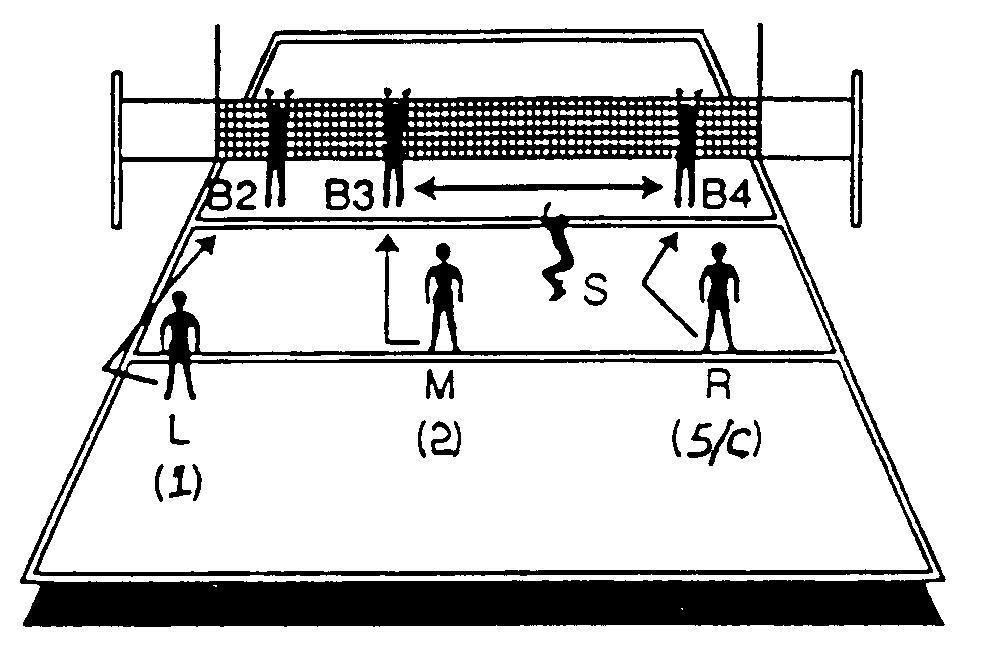
Offensive plays and attacks are designed using the system described in the section Individual Attack Tactics. Below is a diagram to refresh your memory.

Attack Zones 1 and 5 are fixed permanently on the net
1 = High outlet set or shoot set to the left side
5 = High outlet set or shoot set to the right side
Attack Zones 2, 3, 4 move in relation to the location of the setter:
2 = Shoot set to inside left position
3 = Quick set either in front of or behind the setter
4 = Shoot set to inside right position
Attack Zones A, B, C represent back row attack corridors and are permanently fixed in the left, middle and right positions.
Set Selection
Set selection can be analyzed from a variety of different objectives. First, a setter can distribute sets based on the demonstrated success rate of each hitter in each rotation. A second basis for determining set selection can be determined from information about the opponent's block.
A third method for set selection can be found in play combinations. Most blocking schemes are designed to put at least two blockers against every attack. Combination plays have in common the goal of regaining the offensive advantage by giving the hitter a one-on-one (one hitter against one blocker) option. It is the setter's role to select the option that will produce the one-on-one situation.
Spreading the Block
One popular play concept is to spread the block by using attack patterns that tend to increase the distance between two potential points of attack. This makes it difficult for two blockers to combine on a multiple block. The most frequently used play of this type in three-hitter formations is the 2-5 spread. This play is designed to spread the opponent's middle and left blockers. In the figure below, the middle hitter approaches for a 3-ball set in the 2-slot and the right outside hitter stays outside and attacks a 4-ball at the 5-slot. Since both sets are low and quick, it is impossible for the opponent's middle blocker and outside blocker to move together as a tandem to block either hitter. The pressure is on the middle blocker. If she chooses to block the middle hitter then the setter sets the ball to the right outside hitter. If the middle blocker does not move to block the middle hitter but chooses to position herself to block outside, then the setter set the middle hitter. The same effect can be achieved in a two hitter formation by including a back row attack from slot "C."

Another frequently used tactic is to spread the opponents middle and right blockers. This can be achieved easily in two hitter formations by assigning the middle hitter to attack behind the setter at slot 4 or 5. If the middle blocker follows the middle hitter, then the setter pushes a 4-ball to the left outside hitter. In three hitter formations, the same effect can be achieved by having the middle hitter and right outside hitter run any combination BEHIND the setter.

Disrupting the Timing of the Block
This play tactic is designed to overload the blocker with a two-set timing combination that will force the blocker to commit to one set or the other thereby leaving one of the two sets open for a free swing.
These plays usually involve a quick set followed by a second-option set that is slightly higher, but does not allow the blocker time to recover from a jump against the quick set and still be able to jump against the second option. The figure below is such an example.

If the middle blocker commits to staying in the middle to block the quick set to the middle hitter then the setter can run a 2-ball to the right outside hitter who is attacking BEHIND the setter. If the middle blocker does not commit to block the middle attack, then the setter should run the quick set to the middle hitter. This overloading effect can be achieved using any combination of hitters at any zone along the net. Again, the success of the play depends on the setter's ability to set the correct option.
Selecting which hitter to set requires, first, that the setter become aware of the various reasons that justify set selection. Selection can be based on knowledge of your own hitters' strengths, knowledge of the opponent's vulnerabilities, knowledge of tactical concepts, or on any combination of the three. The setter must enter each competition with a game plan detailing how to decide which hitter to set and how this particular setting pattern can defeat the opponent. Anything else will cause the offensive system to lack purpose and tactical effectiveness.
